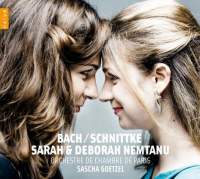Texte paru dans: / Appeared in: |
|
|
Outil de traduction ~ (Très approximatif) |
|
|
Reviewer: Huntley
Dent It’s not news that period performers have made peace with emotions, and the holdouts who tick off each note like calculations on an abacus (you know who you are) tend to be proud ideologues or devoid of imagination. The Bach performed on this new release is done according to current musicology fashion but also communicates enthusiasm and enjoyment. As a sign of imagination, the pairing is Schnittke’s Concerto Grosso No. 3 from 1985, allowing us to hear in close proximity two polarities of the Baroque, as origin and inspiration. The violin soloists are two French sisters, Sarah and Deborah Nemtanu, pictured on the cover butting heads in mock sibling rivalry when in practice they are quite like-minded musically. An interview in the booklet is titled “We have two completely different voices,” but in these spirited performances, correctness counts more than personality, so what I hear is equally detailed and disciplined. This isn’t to detract from the fact that their way with the three Bach violin concertos is nimble and appealing. Deborah is the violist in the Two-Part Inventions. Moving on to Schnittke will be like crossing into no man’s land for some Baroque enthusiasts. He sweetens the trap by beginning so harmlessly, the opening Allegro sounding for several bars like a perfect Baroque pastiche. But with a raucous clang and the arrival of dissonance, the strings suddenly turn into a buzzing hornet’s nest, and the melodic line collapses like candle wax melting in the sun. To quote Deborah Nemtanu from the interview, “For me, the beginning of the Concerto Grosso is extraordinary. You think for a moment you are listening to one of Bach’s Brandenburg Concertos as it has the same elements: harpsichord, strings, and dance. Then the symbolic bell rings, and Schnittke opens his own door. It is another world, and a marvelous discovery.” We are in the domain of Schnittke’s mixed languages, which he dubbed polystylism. He didn’t invent the appropriation of Bach (Villa-Lobos’s Bachianas brasileiras series was ahead of the curve), nor was this a new Modernist gesture (Lukas Foss’s Baroque Variations appeared in 1967). But Schnittke occupies this territory with a more compelling originality and inspiration than his predecessors. The Concerto Grosso No. 3, whose keyboards include piano and celesta besides the harpsichord, takes eerie and violent turns, but you never lose faith that Schnittke feels reverence for his sources while expressing his own musical nature, which is a unique fusion of avant-garde and neo-Romantic. At ages 33 and 31 when this recording was made, the Nemtanu sisters are both gifted soloists as well as concertmasters: Deborah with the Chamber Orchestra of Paris, heard here, and Sarah with the Orchestre National de France. The recorded sound is excellent, but there are no program notes, which is inexcusable when it comes to the Schnittke. I realize that his name frightens the horses in some quarters, but this is a delightful example of cultural cross-pollination that deserves to have wide appeal. | |
|
|
|
|
Cliquez l'un ou l'autre
bouton pour découvrir bien d'autres critiques de CD |
|




